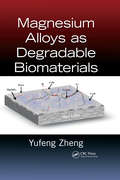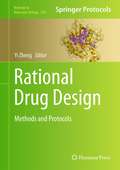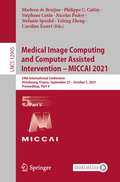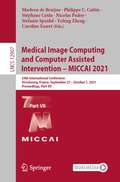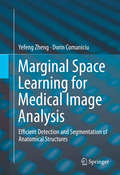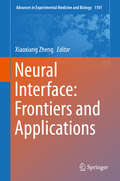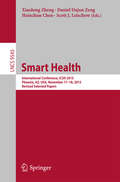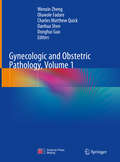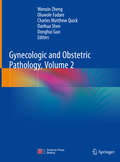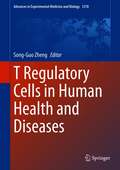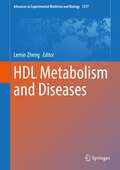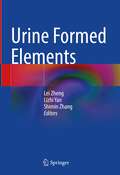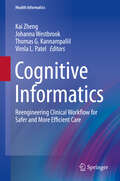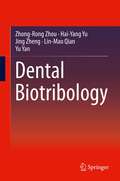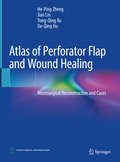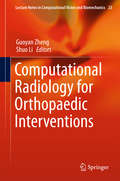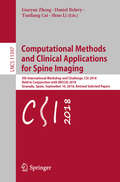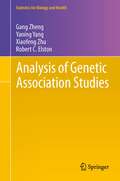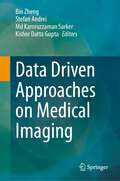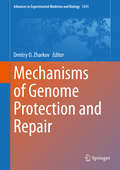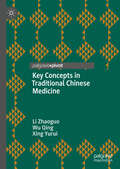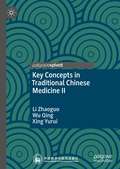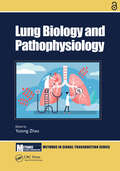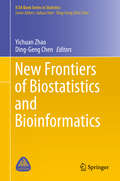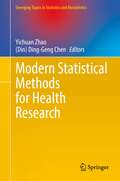- Table View
- List View
Magnesium Alloys as Degradable Biomaterials
by Yufeng ZhengMagnesium Alloys as Degradable Biomaterials provides a comprehensive review of the biomedical applications of biodegradable magnesium and its alloys. Magnesium has seen increasing use in orthopedic and cardiovascular applications over the last decade, particularly for coronary stents and bone implants.The book discusses the basic concepts of biodeg
Rational Drug Design
by Yi ZhengOver the past three decades there have been new developments in therapeutic drug design. In Rational Drug Design: Methods and Protocols, expert researchers in the field detail many of the methodologies used to study rational drug design. These include methods such as virtual screening of chemical hits, rational lead discovery by high throughput screening, combinatorial and fragment based lead generation, peptide based drug discovery, and animal models of lead validation. Written in the highly successful Methods in Molecular BiologyTM series format, chapters include introductions to their respective topics, lists of the necessary materials and reagents, step-by-step, readily reproducible laboratory protocols, and key tips on troubleshooting and avoiding known pitfalls. Authoritative and practical, Rational Drug Design: Methods and Protocols seeks to aid scientists in the further study of rational drug design and future drug discovery.
Medical Image Computing and Computer Assisted Intervention – MICCAI 2021: 24th International Conference, Strasbourg, France, September 27 – October 1, 2021, Proceedings, Part V (Lecture Notes in Computer Science #12905)
by Yefeng Zheng Stéphane Cotin Caroline Essert Stefanie Speidel Philippe C. Cattin Marleen De Bruijne Nicolas PadoyThe eight-volume set LNCS 12901, 12902, 12903, 12904, 12905, 12906, 12907, and 12908 constitutes the refereed proceedings of the 24th International Conference on Medical Image Computing and Computer-Assisted Intervention, MICCAI 2021, held in Strasbourg, France, in September/October 2021.*The 542 revised full papers presented were carefully reviewed and selected from 1809 submissions in a double-blind review process. The papers are organized in the following topical sections: Part I: image segmentation Part II: machine learning - self-supervised learning; machine learning - semi-supervised learning; and machine learning - weakly supervised learning Part III: machine learning - advances in machine learning theory; machine learning - domain adaptation; machine learning - federated learning; machine learning - interpretability / explainability; and machine learning - uncertainty Part IV: image registration; image-guided interventions and surgery; surgical data science; surgical planning and simulation; surgical skill and work flow analysis; and surgical visualization and mixed, augmented and virtual reality Part V: computer aided diagnosis; integration of imaging with non-imaging biomarkers; and outcome/disease prediction Part VI: image reconstruction; clinical applications - cardiac; and clinical applications - vascular Part VII: clinical applications - abdomen; clinical applications - breast; clinical applications - dermatology; clinical applications - fetal imaging; clinical applications - lung; clinical applications - neuroimaging - brain development; clinical applications - neuroimaging - DWI and tractography; clinical applications - neuroimaging - functional brain networks; clinical applications - neuroimaging – others; and clinical applications - oncology Part VIII: clinical applications - ophthalmology; computational (integrative) pathology; modalities - microscopy; modalities - histopathology; and modalities - ultrasound*The conference was held virtually.
Medical Image Computing and Computer Assisted Intervention – MICCAI 2021: 24th International Conference, Strasbourg, France, September 27 – October 1, 2021, Proceedings, Part VII (Lecture Notes in Computer Science #12907)
by Yefeng Zheng Stéphane Cotin Caroline Essert Stefanie Speidel Philippe C. Cattin Marleen De Bruijne Nicolas PadoyThe eight-volume set LNCS 12901, 12902, 12903, 12904, 12905, 12906, 12907, and 12908 constitutes the refereed proceedings of the 24th International Conference on Medical Image Computing and Computer-Assisted Intervention, MICCAI 2021, held in Strasbourg, France, in September/October 2021.*The 542 revised full papers presented were carefully reviewed and selected from 1809 submissions in a double-blind review process. The papers are organized in the following topical sections: Part I: image segmentation Part II: machine learning - self-supervised learning; machine learning - semi-supervised learning; and machine learning - weakly supervised learning Part III: machine learning - advances in machine learning theory; machine learning - domain adaptation; machine learning - federated learning; machine learning - interpretability / explainability; and machine learning - uncertainty Part IV: image registration; image-guided interventions and surgery; surgical data science; surgical planning and simulation; surgical skill and work flow analysis; and surgical visualization and mixed, augmented and virtual reality Part V: computer aided diagnosis; integration of imaging with non-imaging biomarkers; and outcome/disease prediction Part VI: image reconstruction; clinical applications - cardiac; and clinical applications - vascular Part VII: clinical applications - abdomen; clinical applications - breast; clinical applications - dermatology; clinical applications - fetal imaging; clinical applications - lung; clinical applications - neuroimaging - brain development; clinical applications - neuroimaging - DWI and tractography; clinical applications - neuroimaging - functional brain networks; clinical applications - neuroimaging – others; and clinical applications - oncology Part VIII: clinical applications - ophthalmology; computational (integrative) pathology; modalities - microscopy; modalities - histopathology; and modalities - ultrasound*The conference was held virtually.
Marginal Space Learning for Medical Image Analysis
by Yefeng Zheng Dorin ComaniciuAutomatic detection and segmentation of anatomical structures in medical images are prerequisites to subsequent image measurements and disease quantification, and therefore have multiple clinical applications. This book presents an efficient object detection and segmentation framework, called Marginal Space Learning, which runs at a sub-second speed on a current desktop computer, faster than the state-of-the-art. Trained with a sufficient number of data sets, Marginal Space Learning is also robust under imaging artifacts, noise and anatomical variations. The book showcases 35 clinical applications of Marginal Space Learning and its extensions to detecting and segmenting various anatomical structures, such as the heart, liver, lymph nodes and prostate in major medical imaging modalities (CT, MRI, X-Ray and Ultrasound), demonstrating its efficiency and robustness.
Neural Interface: Frontiers and Applications (Advances in Experimental Medicine and Biology #1101)
by Xiaoxiang ZhengThis book focuses on the frontiers of neural interface technology, including hardware, software, neural decoding and encoding, control systems, and system integration. It also discusses applications for neuroprosthetics, neural diseases and neurorobotics, and the toolkits for basic neuroscience. A neural interface establishes a direct communication channel with the central or peripheral nervous system (CNS or PNS), and enables the nervous system to interact directly with the external devices. Recent advances in neuroscience and engineering are speeding up neural interface technology, paving the way for assisting, augmenting, repairing or restoring sensorimotor and other cognitive functions impaired due to neurological disease or trauma, and so improving the quality of life of those affected. Neural interfaces are now being explored in applications as diverse as rehabilitation, accessibility, gaming, education, recreation, robotics and human enhancement. Neural interfaces also represent a powerful tool to address fundamental questions in neuroscience. Recent decades have witnessed tremendous advances in the field, with a huge impact not only in the development of neuroprosthetics, but also in our basic understanding of brain function. Neural interface technology can be seen as a bridge across the traditional engineering and basic neuroscience. This book provides researchers, graduate and upper undergraduate students from a wide range of disciplines with a cutting-edge and comprehensive summary of neural interface engineering research.
Smart Health
by Xiaolong Zheng Daniel Dajun Zeng Hsinchun Chen Scott J. LeischowThis book constitutes the thoroughly refereedpost-conference proceedings of the International Conference for Smart Health,ICSH 2015, held in Phoenix, AZ, USA, in November 2015. The 33 papers presented together were carefully reviewedand selected from 43 submissions. The conference focused on topics and issuesincluding medical monitoring and information extraction, clinical and medicaldata mining, health data analysis and management, big data and smart health,and healthcare intelligent systems and clinical practice.
Gynecologic and Obstetric Pathology, Volume 1
by Wenxin Zheng Oluwole Fadare Charles Matthew Quick Danhua Shen Donghui GuoThis fully indexed, 2-volume book covers all aspects of gynecologic and obstetric pathology. It focuses on practical issues in each chapter by demonstrating pitfalls of diagnosis in addition to general criteria needed for each disease entity. As a reference book on gynecologic and obstetric pathology, it is targeted for practicing pathologists, pathology residents, gynecologic pathology and oncology fellows, clinicians, healthcare providers, and biomedical researchers and is intended for use as a bench or scope side reference, resource for studying for board examinations or to satisfy any interest in certain topics within the field of gynecologic pathology. Volume 1 contains 19 chapters covering disease entities of the vulva, vagina, cervix, and endometrium. It covers all the recognized recent advances within the field. Key diagnostic and differential diagnosis related points are illustrated in numerous tables. In addition, plenty of high quality pictures are presented for the vast majority of entities to facilitate both learning and teaching.
Gynecologic and Obstetric Pathology, Volume 2
by Wenxin Zheng Oluwole Fadare Charles Matthew Quick Danhua Shen Donghui GuoThis fully indexed, 2-volume book covers all aspects of gynecologic and obstetric pathology. It focuses on practical issues in each chapter by demonstrating pitfalls of diagnosis in addition to general criteria needed for each disease entity. As a reference book on gynecologic and obstetric pathology, it is targeted for practicing pathologists, pathology residents, gynecologic pathology and oncology fellows, clinicians, healthcare providers, and biomedical researchers and is intended for use as a bench or scope side reference, resource for studying for board examinations or to satisfy any interest in certain topics within the field of gynecologic pathology. Volume 2 contains 17 chapters covering disease entities of the uterine myometrium, ovary, fallopian tube, peritoneum, placenta, gestational trophoblastic diseases, and gynecology related cytology. It covers all the recognized recent advances within the field. Key diagnostic and differential diagnosis related points are illustrated in numerous tables. In addition, plenty of high quality pictures are presented for the vast majority of entities to facilitate both learning and teaching.
T Regulatory Cells in Human Health and Diseases (Advances in Experimental Medicine and Biology #1278)
by Song-Guo ZhengThis book addresses one of the major challenges of immunology today that is being directed to the translation of the rapidly emerging volume of basic science contributions of immunology to clinical medicine. In so doing, the book systemically introduces and discusses concepts, classifications, phenotypic and functional descriptions of regulatory T (Treg) cells in health and disease. The authors of the 15 chapters were selected from among the most qualified experts in the field of Treg cell research who provide a comprehensive overview of Treg cells and their biology in the ensuing chapters.The beginning chapters provide a useful contemporary classification of Treg cell populations and then progress to chapters that explore basic mechanisms of Treg cell function and epigenetic control. In addition to descriptions of typical CD4+ Foxp3+ cells, other chapters provide detailed presentations of Treg subsets such as CD8+ Tregs and IL-10-producing Tr1 cells. The differences of various Treg subsets, as well as circulating and resident Treg cell populations, are next compared. Importantly, the next chapters provide the clinical correlation of Treg cells with autoimmune diseases, inflammatory diseases, metabolic diseases, cancer and organ transplantation and progress to chapters that highlight emerging innovative technology including nanoparticle-Treg cells and their translational values. In summary, the book will provide a valuable resource not only for graduate students and researchers in the fields of immunology, cell biology and translational medicine but also for all others interested in learning more about Treg cells and their application in human health and disease.
HDL Metabolism and Diseases (Advances in Experimental Medicine and Biology #1377)
by Lemin ZhengThis book focuses on both high-density lipoproteins (HDL) metabolism and related diseases from the perspectives of the world-class experts in HDL. Several chapters in this book provide the overall information about HDL metabolism via detailed discussion of HDL structures as well as several key molecules involved in its functions, such as SR-B1 and Cholesteryl Ester Transfer Protein Inhibitors and so on. The rest of this book illustrates the connection between HDL and several diseases that are the major concerns of people’s health in many countries, and devotes to exploring the therapies of HDL related diseases. With a better understanding of the HDL metabolism and diseases, this book will benefit the audiences with interest in HDL from biomedicine to clinical practice.
Urine Formed Elements
by Lei Zheng Lizhi Yan Shimin ZhangThis book introduces the various urinary formed elements comprehensively, mainly including exfoliated cells, crystals and casts. Since the urinary formed elements are affected by various factors and their morphology may change, these components are identified by combining a variety of staining techniques. Various kinds of clinical classic cases are introduced, which are illustrated by richness high-definition colour pictures.
Cognitive Informatics: Reengineering Clinical Workflow for Safer and More Efficient Care (Health Informatics)
by Kai Zheng Johanna Westbrook Thomas G. Kannampallil Vimla L. PatelThis timely book addresses gaps in the understanding of how health information technology (IT) impacts on clinical workflows and how the effective implementation of these workflows are central to the safe and effective delivery of care to patients. It features clearly structured chapters covering a range of topics, including aspects of clinical workflows relevant to both practitioners and patients, tools for recording clinical workflow data techniques for potentially redesigning health IT enabled care coordination.Cognitive Informatics: Reengineering Clinical Workflow for More Efficient and Safer Care enables readers to develop a deeper understanding of clinical workflows and how these can potentially be modified to facilitate greater efficiency and safety in care provision, providing a valuable resource for both biomedical and health informatics professionals and trainees.
Dental Biotribology
by Jing Zheng Hai-Yang Yu Lin-Mao Qian Yu Yan Zhong-Rong ZhouDental Biotribology summarizes the latest achievements in dental wear and is designed to help the reader better understand the relationship between structures and tribological properties of human teeth. This book provides guidance on the biomimic design of anti-wear engineering systems based on human teeth and also explains mechanisms of occlusal wear and erosion as well as fretting wear related to dental implants and orthodontics. Additionally, this book provides valuable insights into the development of improved dental materials and oral treatments.
Atlas of Perforator Flap and Wound Healing: Microsurgical Reconstruction and Cases
by He-Ping Zheng Jian Lin Yong-Qing Xu De-Qing HuThis Atlas is organized in a way with a combination of basic theory and clinical practices, and of real photos and text description in perforator flap. The book includes four parts: the first part is the overview of the definition, vascular physiology and main principles of clinical applications of the perforator flap, etc.; the second to fourth parts are the descriptions of the indication, applied anatomy, typical clinical cases and key points in harvesting technologies of the direct and indirect perforator flaps over the human body, etc. This Atlas is a useful reference for medical researchers and doctors relevant to microsurgery, hand surgery, orthopaedic surgery, and plastic and reconstructive surgery.
Computational Radiology for Orthopaedic Interventions (Lecture Notes in Computational Vision and Biomechanics #23)
by Guoyan Zheng Shuo LiThis book provides a cohesive overview of the current technological advances in computational radiology, and their applications in orthopaedic interventions. Contributed by the leading researchers in the field, this volume covers not only basic computational radiology techniques such as statistical shape modeling, CT/MRI segmentation, augmented reality and micro-CT image processing, but also the applications of these techniques to various orthopaedic interventional tasks. Details about following important state-of-the-art development are featured: 3D preoperative planning and patient-specific instrumentation for surgical treatment of long-bone deformities, computer assisted diagnosis and planning of periacetabular osteotomy and femoroacetabular impingement, 2D-3D reconstruction-based planning of total hip arthroplasty, image fusion for computer-assisted bone tumor surgery, intra-operative three-dimensional imaging in fracture treatment, augmented reality based orthopaedic interventions and education, medical robotics for musculoskeletal surgery, inertial sensor-based cost-effective surgical navigation, and computer assisted hip resurfacing using patient-specific instrument guides. Edited and authored by leading researchers in the field, this work is an essential reference for biomedical engineers, computer scientists and orthopaedic surgeons to develop or use computational radiology approaches for orthopaedic surgery and interventions.
Computational Methods and Clinical Applications for Spine Imaging: 5th International Workshop and Challenge, CSI 2018, Held in Conjunction with MICCAI 2018, Granada, Spain, September 16, 2018, Revised Selected Papers (Lecture Notes in Computer Science #11397)
by Guoyan Zheng Daniel Belavy Yunliang Cai Shuo LiThis book constitutes the refereed proceedings of the 5th International Workshop and Challenge on Computational Methods and Clinical Applications for Spine Imaging, CSI 2018, held in conjunction with MICCAI 2018, in Granada, Spain, in September 2018. The 8 full papers presented together with 8 short papers and 1 keynote were carefully reviewed and selected for inclusion in this volume. Papers on novel methodology and clinical research, and also papers which demonstrate the performance of methods on the provided challenges, the aim is to cover both theoretical and very practical aspects of computerized spinal imaging.
Analysis of Genetic Association Studies (Statistics for Biology and Health)
by Gang Zheng Xiaofeng Zhu Yaning Yang Robert C. ElstonAnalysis of Genetic Association Studies is both a graduate level textbook in statistical genetics and genetic epidemiology, and a reference book for the analysis of genetic association studies. Students, researchers, and professionals will find the topics introduced in Analysis of Genetic Association Studies particularly relevant. The book is applicable to the study of statistics, biostatistics, genetics and genetic epidemiology. In addition to providing derivations, the book uses real examples and simulations to illustrate step-by-step applications. Introductory chapters on probability and genetic epidemiology terminology provide the reader with necessary background knowledge. The organization of this work allows for both casual reference and close study.
Data Driven Approaches on Medical Imaging
by Bin Zheng Stefan Andrei Md Kamruzzaman Sarker Kishor Datta GuptaThis book deals with the recent advancements in computer vision techniques such as active learning, few-shot learning, zero shot learning, explainable and interpretable ML, online learning, AutoML etc. and their applications in medical domain. Moreover, the key challenges which affect the design, development, and performance of medical imaging systems are addressed. In addition, the state-of-the-art medical imaging methodologies for efficient, interpretable, explainable, and practical implementation of computer imaging techniques are discussed. At present, there are no textbook resources that address the medical imaging technologies. There are ongoing and novel research outcomes which would be useful for the development of novel medical imaging technologies/processes/equipment which can improve the current state of the art.The book particularly focuses on the use of data driven new technologies on medical imaging vision such as Active learning, Online learning, few shot learning, AutoML, segmentation etc.
Mechanisms of Genome Protection and Repair (Advances in Experimental Medicine and Biology #1241)
by Dmitry O. ZharkovDNA is under constant challenge from environmental and endogenous metabolic assaults. Several layers of defence and repair systems allow cells to maintain stable genomes; in humans, dysfunction of these systems leads to cancer, neurodegeneration, and other pathologies. At the same time, recently it had emerged that targeted and regulated DNA damage and repair is a mechanism underlying several important cellular processes such as epigenetic demethylation and immunoglobulin gene diversification. The present collection of papers is aimed to cover new developments in the area of protective and regulatory mechanisms associated with DNA damage. The mechanisms ruling the recognition of damaged nucleotides against the vast background of normal ones are reviewed. The role of extended non-catalytic domains that are often found in eukaryotic DNA repair proteins in contrast to their downsized, catalytic-only bacterial counterparts is discussed. Among the proposed subjects are the regulatory functions of bulky covalent modifications such as poly(ADP)ribosylation and ubiquitylation in DNA damage response, especially in the context of chromatin remodelling. As opposed to DNA repair, damage tolerance allows cells to replicate with lesions in the genome; the enzymes responsible are also covered. Finally, we present examples of modern multilevel understanding of the cell function and malfunction in the wake of genotoxic assaults such as oxidative stress, abiotic environmental stress, and DNA-damaging plant toxins.
Key Concepts in Traditional Chinese Medicine
by Li Zhaoguo Wu Qing Xing YuruiThis book offers a comprehensive overview of Chinese medicine terminology translation, defining the most central concepts in Chinese traditional medicine, providing simplified Chinese characters, Mandarin Pronunciation in pinyin, citations for 111 of the most key concepts in traditional Chinese medicine and culture. Covering definitions of terms relating to essence, qi, yin-yang theory, five elements and visceral manifestation in traditional medicine, it offers a selection of English versions of each term in addition to a standard English version, drawing on the translation history of traditional Chinese medicine. It provides a useful resource to understand the fundamental terms of traditional Chinese medicine and culture in Chinese and English, and their relevance to cross-cultural discourse.
Key Concepts in Traditional Chinese Medicine II
by Li Zhaoguo Wu Qing Xing YuruiThis book offers an overview of Chinese medicine terminology translation, defining the central concepts in Chinese traditional medicine, providing simplified Chinese characters, Mandarin Pronunciation in pinyin, citations for 110 of the most key concepts in traditional Chinese medicine and culture. Covering definitions of terms relating to visceral manifestation, meridians, etiology, pathogenesis, and treatment principles in traditional medicine, it offers a selection of English versions of each term in addition to a standard of English version, drawing on the translation history of traditional Chinese medicine. It provides a useful resource to understand the fundamental terms of traditional Chinese medicine and culture in Chinese and English, and their relevance to cross-cultural discourse.
Lung Biology and Pathophysiology (Methods in Signal Transduction Series)
by Yutong ZhaoThe lungs are the organ for gas exchange between the body and the external environment. Dysfunction of upper airway epithelium and smooth muscle cells leads to pathogenesis of asthma, chronic obstructive pulmonary disease (COPD), cystic fibrosis, and other conditions, resulting in airway inflammation and narrowing. Injury to alveolar epithelium and endothelium causes influx of neutrophil and protein-rich fluid from circulation, resulting in edema and disruption of gas exchange. In addition to lung structural cells, immune cells, including alveolar macrophages and lymphocytes play critical roles in the maintenance of lung function. This book contributes to the understanding homeostasis of lung cells in the physiological and pathological conditions critical to the development of novel therapeutics.Key Features Highlights the role the lungs play as an interface between the body and the environment Describes the underlying mechanism of lung diseases Emphasizes the ways nutrition contributes to lung health as well as the ways pollution adversely affect lung function Includes contributions from leading researchers Chapters 8 and 13 of this book are available for free in PDF format as Open Access from the individual product page at www.routledge.com. It has been made available under a Creative Commons Attribution-Non Commercial-No Derivatives 4.0 license.
New Frontiers of Biostatistics and Bioinformatics (ICSA Book Series in Statistics)
by Yichuan Zhao Ding-Geng ChenThis book is comprised of presentations delivered at the 5th Workshop on Biostatistics and Bioinformatics held in Atlanta on May 5-7, 2017. Featuring twenty-two selected papers from the workshop, this book showcases the most current advances in the field, presenting new methods, theories, and case applications at the frontiers of biostatistics, bioinformatics, and interdisciplinary areas.Biostatistics and bioinformatics have been playing a key role in statistics and other scientific research fields in recent years. The goal of the 5th Workshop on Biostatistics and Bioinformatics was to stimulate research, foster interaction among researchers in field, and offer opportunities for learning and facilitating research collaborations in the era of big data. The resulting volume offers timely insights for researchers, students, and industry practitioners.
Modern Statistical Methods for Health Research (Emerging Topics in Statistics and Biostatistics)
by Yichuan Zhao Din Ding-Geng ChenThis book brings together the voices of leading experts in the frontiers of biostatistics, biomedicine, and the health sciences to discuss the statistical procedures, useful methods, and novel applications in biostatistics research. It also includes discussions of potential future directions of biomedicine and new statistical developments for health research, with the intent of stimulating research and fostering the interactions of scholars across health research related disciplines. Topics covered include: Health data analysis and applications to EHR data Clinical trials, FDR, and applications in health science Big network analytics and its applications in GWAS Survival analysis and functional data analysis Graphical modelling in genomic studies The book will be valuable to data scientists and statisticians who are working in biomedicine and health, other practitioners in the health sciences, and graduate students and researchers in biostatistics and health.
